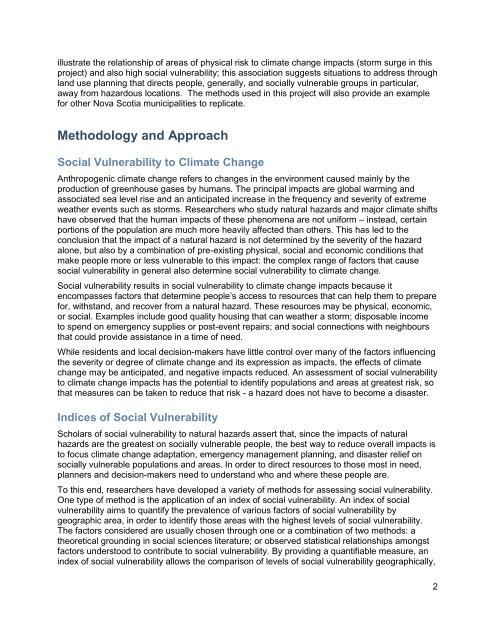Lunenburg Part 2 - Section 5 - Social Vulnerability - August 30.pdf
Lunenburg Part 2 - Section 5 - Social Vulnerability - August 30.pdf
Lunenburg Part 2 - Section 5 - Social Vulnerability - August 30.pdf
Create successful ePaper yourself
Turn your PDF publications into a flip-book with our unique Google optimized e-Paper software.
illustrate the relationship of areas of physical risk to climate change impacts (storm surge in this<br />
project) and also high social vulnerability; this association suggests situations to address through<br />
land use planning that directs people, generally, and socially vulnerable groups in particular,<br />
away from hazardous locations. The methods used in this project will also provide an example<br />
for other Nova Scotia municipalities to replicate.<br />
Methodology and Approach<br />
<strong>Social</strong> <strong>Vulnerability</strong> to Climate Change<br />
Anthropogenic climate change refers to changes in the environment caused mainly by the<br />
production of greenhouse gases by humans. The principal impacts are global warming and<br />
associated sea level rise and an anticipated increase in the frequency and severity of extreme<br />
weather events such as storms. Researchers who study natural hazards and major climate shifts<br />
have observed that the human impacts of these phenomena are not uniform – instead, certain<br />
portions of the population are much more heavily affected than others. This has led to the<br />
conclusion that the impact of a natural hazard is not determined by the severity of the hazard<br />
alone, but also by a combination of pre-existing physical, social and economic conditions that<br />
make people more or less vulnerable to this impact: the complex range of factors that cause<br />
social vulnerability in general also determine social vulnerability to climate change.<br />
<strong>Social</strong> vulnerability results in social vulnerability to climate change impacts because it<br />
encompasses factors that determine people’s access to resources that can help them to prepare<br />
for, withstand, and recover from a natural hazard. These resources may be physical, economic,<br />
or social. Examples include good quality housing that can weather a storm; disposable income<br />
to spend on emergency supplies or post-event repairs; and social connections with neighbours<br />
that could provide assistance in a time of need.<br />
While residents and local decision-makers have little control over many of the factors influencing<br />
the severity or degree of climate change and its expression as impacts, the effects of climate<br />
change may be anticipated, and negative impacts reduced. An assessment of social vulnerability<br />
to climate change impacts has the potential to identify populations and areas at greatest risk, so<br />
that measures can be taken to reduce that risk - a hazard does not have to become a disaster.<br />
Indices of <strong>Social</strong> <strong>Vulnerability</strong><br />
Scholars of social vulnerability to natural hazards assert that, since the impacts of natural<br />
hazards are the greatest on socially vulnerable people, the best way to reduce overall impacts is<br />
to focus climate change adaptation, emergency management planning, and disaster relief on<br />
socially vulnerable populations and areas. In order to direct resources to those most in need,<br />
planners and decision-makers need to understand who and where these people are.<br />
To this end, researchers have developed a variety of methods for assessing social vulnerability.<br />
One type of method is the application of an index of social vulnerability. An index of social<br />
vulnerability aims to quantify the prevalence of various factors of social vulnerability by<br />
geographic area, in order to identify those areas with the highest levels of social vulnerability.<br />
The factors considered are usually chosen through one or a combination of two methods: a<br />
theoretical grounding in social sciences literature; or observed statistical relationships amongst<br />
factors understood to contribute to social vulnerability. By providing a quantifiable measure, an<br />
index of social vulnerability allows the comparison of levels of social vulnerability geographically,<br />
2














